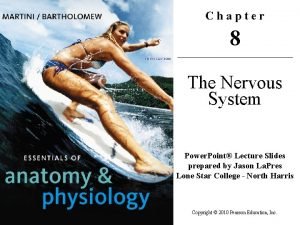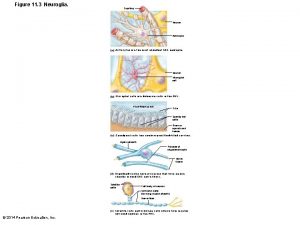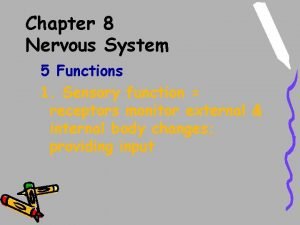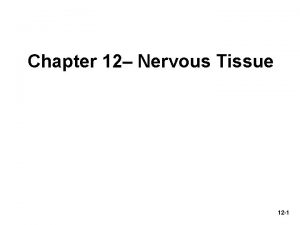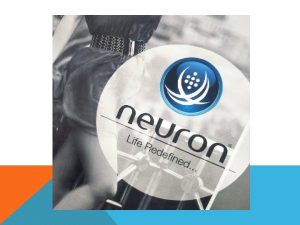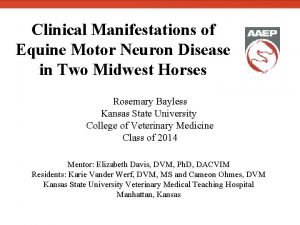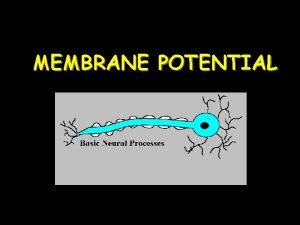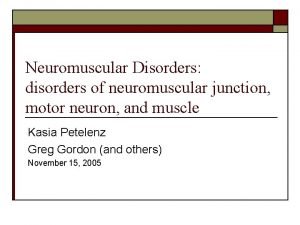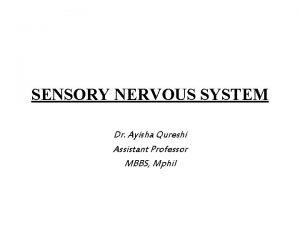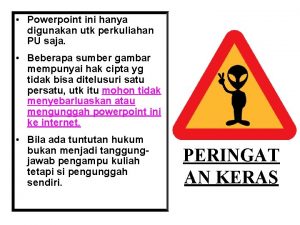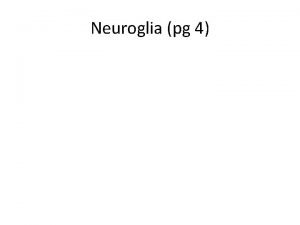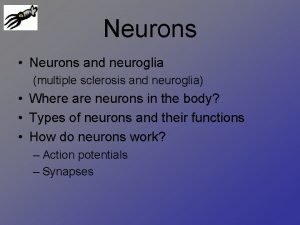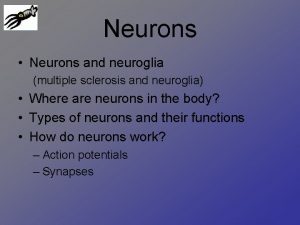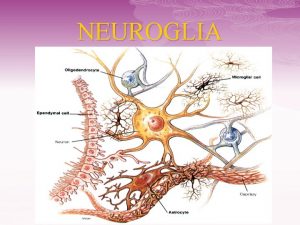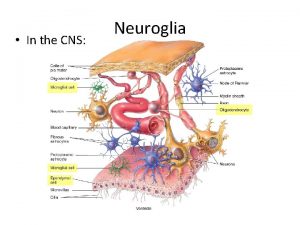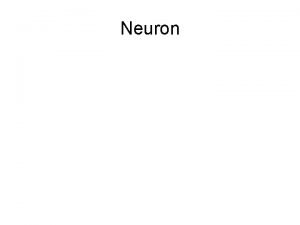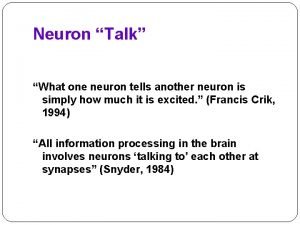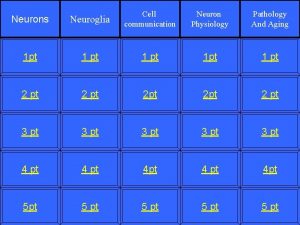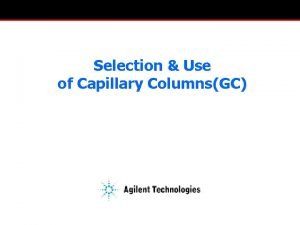Figure 11 3 Neuroglia Capillary Neuron Astrocytes are














- Slides: 14

Figure 11. 3 Neuroglia. Capillary Neuron Astrocytes are the most abundant CNS neuroglia. Neuron Microglial cells are defensive cells in the CNS. Fluid-filled cavity Cilia Ependymal cells Brain or spinal cord tissue Ependymal cells line cerebrospinal fluid–filled cavities. Myelin sheath Process of oligodendrocyte Nerve fibers Oligodendrocytes have processes that form myelin sheaths around CNS nerve fibers. Satellite cells Cell body of neuron Schwann cells (forming myelin sheath) Nerve fiber © 2014 Pearson Education, Inc. Satellite cells and Schwann cells (which form myelin) surround neurons in the PNS.

Figure 11. 3 a Neuroglia. Capillary Neuron Astrocytes are the most abundant CNS neuroglia. © 2014 Pearson Education, Inc.

Figure 11. 3 b Neuroglia. Neuron Microglial cells are defensive cells in the CNS. © 2014 Pearson Education, Inc.

Figure 11. 3 c Neuroglia. Fluid-filled cavity Cilia Ependymal cells Brain or spinal cord tissue Ependymal cells line cerebrospinal fluid–filled cavities. © 2014 Pearson Education, Inc.

Figure 11. 3 d Neuroglia. Myelin sheath Process of oligodendrocyte Nerve fibers Oligodendrocytes have processes that form myelin sheaths around CNS nerve fibers. © 2014 Pearson Education, Inc.

Figure 11. 3 e Neuroglia. Satellite cells Cell body of neuron Schwann cells (forming myelin sheath) Nerve fiber Satellite cells and Schwann cells (which form myelin) surround neurons in the PNS. © 2014 Pearson Education, Inc.

Figure 11. 4 Structure of a motor neuron. Dendrites (receptive regions) Neuron cell body Cell body (biosynthetic center and receptive region) Nucleus Axon (impulse-generating and -conducting region) Nucleolus Chromatophilic substance (rough endoplasmic reticulum) Axon hillock Dendritic spine Impulse direction Myelin sheath gap (node of Ranvier) Schwann cell Terminal branches © 2014 Pearson Education, Inc. Axon terminals (secretory region)

© 2014 Pearson Education, Inc.

© 2014 Pearson Education, Inc.

Table 11. 1 Comparison of Structural Classes of Neurons (2 of 3) © 2014 Pearson Education, Inc.

Figure 11. 16 b Synapses. Axon Axosomatic synapses Cell body (soma) of postsynaptic neuron © 2014 Pearson Education, Inc.

Figure 11. 11 The action potential (AP) is a brief change in membrane potential in a “patch” of membrane that is depolarized by local currents. (3 of 11) The big picture 2 Depolarization Membrane potential (m. V) 1 Resting state +30 3 3 Repolarization 0 Action potential 2 Threshold – 55 – 70 1 0 © 2014 Pearson Education, Inc. 4 Hyperpolarization 1 4 1 2 3 Time (ms) 4

Figure 11. 17 Chemical synapses transmit signals from one neuron to another using neurotransmitters. (1 of 3) Presynaptic neuron Postsynaptic neuron 1 Action potential arrives at axon terminal. 2 Voltage-gated Ca 2+ channels open and Ca 2+ enters the axon terminal. 3 Ca 2+ entry causes synaptic vesicles to release neurotransmitter by exocytosis 4 Neurotransmitter diffuses across the synaptic cleft and binds to specific receptors on the postsynaptic membrane. © 2014 Pearson Education, Inc. Axon terminal Mitochondrion Synaptic cleft Synaptic vesicles Postsynaptic neuron

Membrane potential (m. V) Figure 11. 18 Postsynaptic potentials can be excitatory or inhibitory. +30 0 Threshold – 55 – 70 An EPSP is a local depolarization of the postsynaptic membrane that brings the neuron closer to AP threshold. Neurotransmitter binding opens chemically gated ion channels, allowing Na+ and K+ to pass through simultaneously. Stimulus 10 20 30 Time (ms) Membrane potential (m. V) Excitatory postsynaptic potential (EPSP) +30 0 Threshold An IPSP is a local hyperpolarization of the postsynaptic membrane that drives the neuron away from AP threshold. Neurotransmitter binding opens K+ or Cl– channels. – 55 – 70 Stimulus 10 20 30 Time (ms) © 2014 Pearson Education, Inc. Inhibitory postsynaptic potential (IPSP)
 Figure 8-2 neurons and neuroglia
Figure 8-2 neurons and neuroglia Mikael ferm
Mikael ferm Neuroglia
Neuroglia Neuroglia
Neuroglia Neuroglia
Neuroglia Figure 12-1 the neuron
Figure 12-1 the neuron Figure 11-9 is a diagram of the hepatic portal circulation
Figure 11-9 is a diagram of the hepatic portal circulation Neuron sterilizer
Neuron sterilizer Equine motor neuron disease
Equine motor neuron disease Quizlet
Quizlet Cns histology ppt
Cns histology ppt Motor neuron
Motor neuron Which part of the neuron serves as the protective coating?
Which part of the neuron serves as the protective coating? Receptive fields of sensory neurons
Receptive fields of sensory neurons Site:slidetodoc.com
Site:slidetodoc.com
